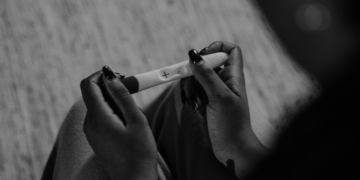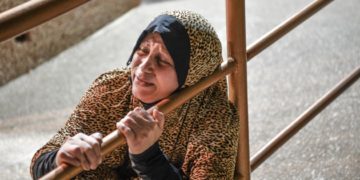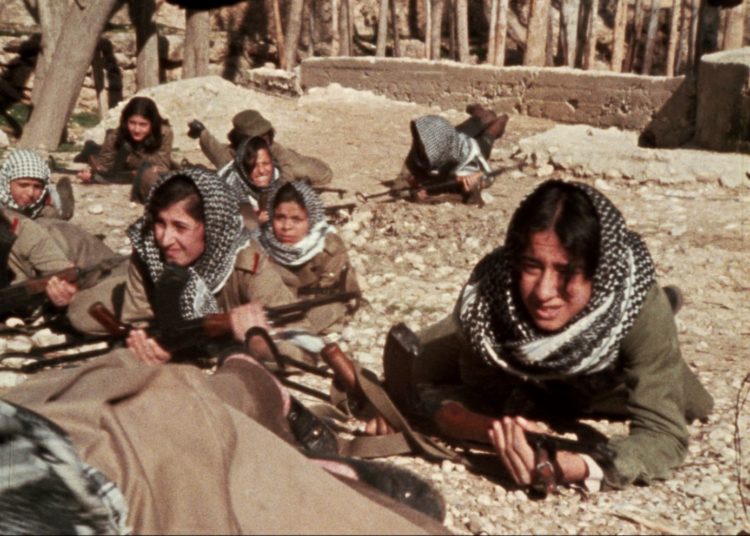This post is also available in: Français (French) العربية (Arabic)
Chadia Khedhir
It was not easy for Tunisian ballet dancer Nesrine Ben Arbia to decide, in 2017, to leave glittering opera halls and their elite audiences to perform instead in the streets. She faced legal challenges, as permits are needed to perform in public spaces, and she also had to deal with fear of extremist groups and societal rejection. Still, Ben Arbia was determined to break down the barriers separating art from the general public and introduce ballet to public spaces. A kind of creative democracy.
Reclaiming the street with dance
 In March 2012, extremists (1) attacked a group of artists and intellectuals during their celebration of World Theater Day. They had organized expressive artistic performances to be delivered in the street in front of the Théâtre municipal de Tunis, which has witnessed Tunisia’s creative history since the beginning of the nineteenth century.
In March 2012, extremists (1) attacked a group of artists and intellectuals during their celebration of World Theater Day. They had organized expressive artistic performances to be delivered in the street in front of the Théâtre municipal de Tunis, which has witnessed Tunisia’s creative history since the beginning of the nineteenth century.
The attack was not only directed against the artists but was against the idea of transforming the street into a space for free expression. These events sparked a direct confrontation between the extremist movements and the artists and intellectuals who, after the 2011 revolution, had been trying to free the street from the grip of the police and transform it into a major platform for art. The clashes and provocations pushed the Ministry of the Interior to impose a system of prior authorization for any type of demonstration or public event, thus making public space even more strictly regulated and restricted. Despite this, Ben Arbia has carried out ballet performances and filming sessions in multiple places such as the old city, La Marsa, Sidi Bou Said, El Kef, and Mahdia.
Ben Arbia confirms that she is careful about her choice of public spaces. “I prefer spots that are full of life, history, and stories. I choose authentic Tunisian architecture as a backdrop for my performances. I see these spaces as part of the narrative of my performances. Art comes from the street and must return to it.”
Ben Arbia has faced hate speech and insults, especially on social media, but strangely, unlike what unfurls in cyberspace, she has not experienced verbal or physical violence in the street. In an interview with the BBC, she said, “I’m not afraid to exercise my right to claim part of the Tunisian street. I’m not imposing my dances on anyone. It’s fine for some people not to like my art, but why the violence?”
When it comes to violence against women in public spaces, urban planning and gender consultant Hind Qafsi says, “Hate speech against women in the public sphere is due to a patriarchal culture based on the misinterpretation of religion that considers a woman’s natural place to be inside the home. In that sense she must remain within the family and devote herself to her biological role: giving birth and caring for her family, children, and husband.” Qafsi adds, “Despite the active participation of Tunisian women in economic life thanks to the high percentage of educated women—70% of Tunisian women have university degrees—their presence in public space for purposes other than work and family care is still met with rejection and disapproval. Women singing, dancing, or drawing in the street is widely seen as indecent, is believed to arouse male desire. They are seen as operating outside their traditional roles of childbearing and raising a family.”
“These spaces [are] part of the narrative of my performances. Art comes from the street and must return to it.”
The Super Tunisian and the crisis of violence
 Only four months after Tunisian President Zine el-Abidine Ben Ali fled on January 14, 2011, following popular protests against his police regime, visual artist, photographer, and filmmaker Moufida Fedhila decided to criticize the government institutions that controlled art and freedom of expression through a project she called “The Super Tunisian,” inspired by the new social and political conditions after the fall of the Ben Ali regime. Fedhila wore a Superman costume and walked the streets carrying a sign that said Super Tunisian.
Only four months after Tunisian President Zine el-Abidine Ben Ali fled on January 14, 2011, following popular protests against his police regime, visual artist, photographer, and filmmaker Moufida Fedhila decided to criticize the government institutions that controlled art and freedom of expression through a project she called “The Super Tunisian,” inspired by the new social and political conditions after the fall of the Ben Ali regime. Fedhila wore a Superman costume and walked the streets carrying a sign that said Super Tunisian.
In this project, Fedhila called for building a new society that would be compatible with the situation that had been created by the revolution. She encouraged people to vote for a single candidate: the Super Tunisian—the ordinary Tunisian who was able to overthrow the old regime. During that revolutionary moment, the country was wide open to various Islamist and extremist ideological currents that sought to exploit the moment and transform it to serve their own ideology.
Abdel Wahed al-Makni, Professor of Contemporary History and Historical Anthropology at the University of Tunis, says, “Women were excluded from public space in Tunisia during the colonial period and continued to be until the beginning of independence. The public practice of art, in all its forms, was rejected and considered worthless by both men and women. Female artists such as Fadhila Khetmi, Fethia Khaïri, and Hassiba Roushdy (2) faced great difficulties at the beginning of their artistic careers.”
As for the actual participation of women in public life, al-Makni claims it began to crystallize with the emergence of student movements in the early seventies. As scores of female teachers and nurses started to graduate and engage in professional life, the foundation was laid for women to enter and be accepted into the public sphere.
Contemporary female artists in the street
On February 27, 2011, at the heart of the revolutionary moment and the sit-in that took place at the Kasbah Square, and in the midst of the political changes that were sweeping the country, visual artist Faten Rouissi participated in a symbolic artistic event along with a group of her students and other artists, as well as other young men and women. Rouissi painted and colored the cars that had been burned by protestors in a square in Al Karm. The cars belonged to the in-laws of former President Ben Ali, and Tunisians had burned them to express their anger and pain. But Rouissi decided to transform the scene of destruction into something artistic that would reflect hope and freedom in a “Street Art—Art in the Neighborhood” demonstration.
“As an artist,” Rouissi says, “I saw in the burned cars shapes and sizes that seemed to be in a state of birth. They were like large-scale sculptures emitting an artistic and aesthetic energy, and they generated contemporary works of art. Chance played a major role in their creation.”

She continues, “The artistic drive was mixed into a moment of awareness and deep questioning: are we going to continue burning things down, or will we move on to a stage where we build another Tunisia, a more colorful one, in which culture and contemporary art have a more prominent standing, away from the old public policies that confined art to folklore and reproduction?”
Rouissi’s art movement began on the morning of February 27, 2011, and it continued until the late hours of the same day. Many volunteers took part in it, under the protection of security forces and with the municipality’s blessing. The space in which cars had been burnt was transformed into an artistic workshop. Public space was used to harness artistic energy and became a stage for events.
“The artistic drive was mixed into a moment of awareness and deep questioning: are we going to continue burning things down, or will we move on to a stage where we build another Tunisia?”
Only one of these colorful cars still remains. It is on display in the courtyard of the National School of Architecture and Urbanism in the capital. In March of the same year, Rouissi also set up an exhibition that included some photos documenting the experience. Besides the one remaining car, the artist is filled with grief because she considers that public space is no longer open to her the way it had been back then—the Ministry of the Interior has regained its full arbitrary power. “It was a phase, and it's over now,” she laments. “What’s different today is that we’ve lost hope in the effectiveness of the strategies for change that are launched by groups and alliances. It might be that the individual is the true direction for change, not the group. Maybe individual acts that are open to the world are more effective than trying to make change by going out into public space.”
Breaking the fourth wall
Since 2007, in the heart of the old city, the public has grown used to following daily adventures called for by the Dream City Festival. It’s considered to be an inclusive festival as it gives important space to women—singers, actresses, and visual artists.
The Dream City Festival is organized by the L'Art Rue association, whose goal is to rediscover the old city, its alleys, its hidden stories. The festival includes contemporary art, dance, music, and theatrical performances. It also produces multiple forms of artistic expression that conform to new standards, creating a sense of harmony with the urban space and architectural fabric of the city.
Playwright and journalist Souad Ben Slimane recalls her participation in the Dream City Festival in 2010, when she presented a play in Sidi Ben Arous Street entitled Padam Padam, after the famous song by French singer Edith Piaf. Ben Slimane says, “The show is a theatrical performance that goes on for about fifteen minutes. It establishes a different kind of relationship with the audience, as it goes beyond the classical division that separates the stage from the audience. It has a new architectural structure that breaks down what in theater is called the fourth wall, the barrier between the actors and the audience. As for the script, it’s dynamic, it changes, as it relies on the direct, real-time relationship with the interactive audience. In this context, script writing for public spaces takes into account the space itself, the décor, and it’s divided into scenes like in cinema.”
 Ben Slimane continues, “No two shows are the same. Each has its own flavor, influenced by the passersby whom I address directly.” Ben Slimane does not recall ever being subjected to violence from curious passersby who stopped to look at her performances. On the contrary, she retains a strong sense of freedom and an overwhelming sense of owning the street. “The Dream City Festival has created an economic dynamism and movement in the old city, raising awareness among residents about the importance of culture and art,” she says. “People really interacted with the festival, and some even offered help to the artists by opening up their shops for costume changes or by directing passersby to other performance locations.”
Ben Slimane continues, “No two shows are the same. Each has its own flavor, influenced by the passersby whom I address directly.” Ben Slimane does not recall ever being subjected to violence from curious passersby who stopped to look at her performances. On the contrary, she retains a strong sense of freedom and an overwhelming sense of owning the street. “The Dream City Festival has created an economic dynamism and movement in the old city, raising awareness among residents about the importance of culture and art,” she says. “People really interacted with the festival, and some even offered help to the artists by opening up their shops for costume changes or by directing passersby to other performance locations.”
The street, as a public space for art, gave Ben Slimane a stronger connection to the place. “The street has its magic and mysteries. Some streets are more emotionally charged than others,” she asserts, “because of the stories they carry about the transformations that Tunisia has gone through. On Habib Bourguiba Avenue in the capital, there is a radiant, inspiring energy that is full of symbolism and meaning. This street represents the heart of debate and conflict between the different forces and movements that seek to control it, but despite all the attempts, it remains difficult for one side to take over. The street hasn’t said its last word yet.”
Tunisian playwrights continue the “journey” – Al-Akhbar newspaper – 31/3/2012
Fadhila Khetmi, Fethia Khaïri, and Hassiba Roushdy are actresses and singers who rose to fame in Tunisia at the beginning of the twentieth century.
This investigation was carried out with the support of the Tunis Office of the Rosa Luxemburg Foundation.































